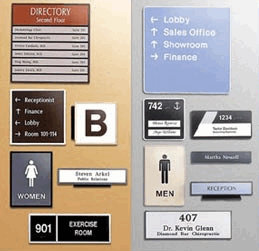A Comprehensive Overview to Picking the Right ADA Signs
Wiki Article
Exploring the Secret Features of ADA Signs for Boosted Accessibility
In the realm of accessibility, ADA signs offer as quiet yet powerful allies, guaranteeing that rooms are accessible and comprehensive for people with impairments. By incorporating Braille and responsive elements, these indications break barriers for the visually impaired, while high-contrast color plans and clear font styles cater to varied visual requirements.Importance of ADA Compliance
Making sure compliance with the Americans with Disabilities Act (ADA) is important for cultivating inclusivity and equivalent accessibility in public spaces and offices. The ADA, established in 1990, mandates that all public centers, companies, and transportation services accommodate individuals with handicaps, guaranteeing they enjoy the very same rights and opportunities as others. Compliance with ADA standards not just satisfies legal responsibilities yet likewise enhances an organization's online reputation by showing its dedication to diversity and inclusivity.Among the vital aspects of ADA compliance is the implementation of easily accessible signage. ADA signs are developed to make sure that individuals with specials needs can quickly browse with buildings and rooms. These indications must stick to specific standards pertaining to size, typeface, color contrast, and placement to ensure exposure and readability for all. Properly executed ADA signage helps get rid of barriers that individuals with handicaps usually experience, thus advertising their freedom and self-confidence (ADA Signs).
Moreover, adhering to ADA laws can mitigate the risk of prospective penalties and legal effects. Organizations that fail to abide by ADA guidelines may deal with penalties or suits, which can be both financially troublesome and harmful to their public photo. Thus, ADA compliance is essential to promoting an equitable atmosphere for every person.
Braille and Tactile Elements
The consolidation of Braille and tactile components into ADA signs embodies the concepts of access and inclusivity. It is typically positioned beneath the matching message on signage to guarantee that people can access the info without visual support.Tactile aspects extend beyond Braille and include increased icons and characters. These elements are created to be discernible by touch, permitting people to determine space numbers, bathrooms, exits, and various other vital locations. The ADA sets details standards pertaining to the dimension, spacing, and placement of these responsive elements to enhance readability and ensure uniformity throughout different environments.

High-Contrast Color Pattern
High-contrast color design play a pivotal duty in boosting the presence and readability of ADA signage for individuals with aesthetic disabilities. These schemes are essential as they optimize the difference in light reflectance in between text and history, guaranteeing that indicators are easily noticeable, even from a range. The Americans with Disabilities Act (ADA) mandates making use of details color contrasts to suit those with limited vision, making it a crucial element of conformity.The effectiveness of high-contrast shades depends on their capacity to stick out in various lighting problems, including poorly lit environments and locations with glare. Typically, dark text on a light history or light text on a dark background is utilized to accomplish optimal comparison. Black message on a white or yellow history provides a plain aesthetic distinction that aids in fast acknowledgment and understanding.

Legible Fonts and Text Size
When considering the style of ADA signs, the selection of legible fonts and proper message size can not be overstated. The Americans with Disabilities Act (ADA) mandates that fonts must be sans-serif and not italic, oblique, manuscript, very attractive, or of uncommon form.According to view publisher site ADA standards, the minimum text elevation ought to be 5/8 inch, and it needs to boost proportionally with watching range. Consistency in text size contributes to a natural visual experience, aiding individuals in navigating environments effectively.
Additionally, spacing in between letters and lines is indispensable to legibility. Ample spacing prevents personalities from showing up crowded, boosting readability. By sticking to these requirements, developers can considerably improve accessibility, guaranteeing that signage offers its designated function for all people, despite their visual abilities.
Reliable Positioning Strategies
Strategic positioning of ADA signage is important for taking full advantage of accessibility and guaranteeing compliance with legal requirements. ADA standards state that signs should be installed at a height between 48 to 60 inches from the ground to guarantee they are within the line of sight for both standing and seated people.In addition, indications have to be put nearby to the lock side of doors to allow simple recognition before entry. Uniformity in indication positioning throughout a center boosts predictability, reducing confusion and enhancing overall user experience.

Verdict
ADA signs play an essential function in advertising availability by incorporating functions that resolve the requirements of people with specials needs. These elements collectively foster a comprehensive atmosphere, highlighting the significance of ADA conformity in making certain equal access for all.In the realm of access, ADA indicators offer as silent yet powerful allies, making sure that areas are accessible and inclusive for individuals with specials needs. The ADA, enacted in 1990, mandates that all public facilities, companies, and transport solutions accommodate individuals with specials needs, guaranteeing they enjoy the same legal rights and opportunities as others. ADA Signs. ADA indications are designed to make top article certain that individuals with impairments can easily navigate with structures and rooms. ADA standards specify that signs ought to be installed at an elevation between 48 to 60 inches from the ground to guarantee they are within the line of view for both standing and seated people.ADA indicators play a vital function in advertising ease of access by integrating features that address the demands of individuals with specials needs
Report this wiki page